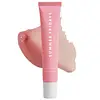What's inside
What's inside
 Key Ingredients
Key Ingredients

 Benefits
Benefits

 Concerns
Concerns

 Ingredients Side-by-side
Ingredients Side-by-side

Polyglyceryl-2 Isostearate/Dimer Dilinoleate Copolymer
EmollientDilinoleic Acid/Propanediol Copolymer
EmollientVitis Vinifera Seed Oil
EmollientCarthamus Tinctorius Seed Oil
MaskingMel
EmollientSimmondsia Chinensis Seed Oil
EmollientLimnanthes Alba Seed Oil
Skin ConditioningCalendula Officinalis Flower Extract
MaskingOenothera Biennis Oil
EmollientRosa Canina Fruit Oil
EmollientHydrogenated Castor Oil/Sebacic Acid Copolymer
EmollientPropolis Cera
AntiseborrhoeicHelianthus Annuus Seed Oil
EmollientTocopheryl Acetate
AntioxidantTocopherol
AntioxidantSodium Hyaluronate
HumectantCitrus Aurantium Bergamia Fruit Extract
Skin ConditioningDaucus Carota Sativa Root Extract
Skin ConditioningMauritia Flexuosa Fruit Oil
Skin ConditioningVaccinium Myrtillus Seed Oil
Skin ConditioningGlucomannan
Skin ConditioningEthylhexyl Palmitate
EmollientAroma
Calcium Sodium Borosilicate
Trihydroxystearin
Skin ConditioningTin Oxide
AbrasiveCitral
PerfumingLinalool
PerfumingLimonene
PerfumingCI 77891
Cosmetic ColorantCI 15850
Cosmetic ColorantPolyglyceryl-2 Isostearate/Dimer Dilinoleate Copolymer, Dilinoleic Acid/Propanediol Copolymer, Vitis Vinifera Seed Oil, Carthamus Tinctorius Seed Oil, Mel, Simmondsia Chinensis Seed Oil, Limnanthes Alba Seed Oil, Calendula Officinalis Flower Extract, Oenothera Biennis Oil, Rosa Canina Fruit Oil, Hydrogenated Castor Oil/Sebacic Acid Copolymer, Propolis Cera, Helianthus Annuus Seed Oil, Tocopheryl Acetate, Tocopherol, Sodium Hyaluronate, Citrus Aurantium Bergamia Fruit Extract, Daucus Carota Sativa Root Extract, Mauritia Flexuosa Fruit Oil, Vaccinium Myrtillus Seed Oil, Glucomannan, Ethylhexyl Palmitate, Aroma, Calcium Sodium Borosilicate, Trihydroxystearin, Tin Oxide, Citral, Linalool, Limonene, CI 77891, CI 15850
Phytosteryl/Isostearyl/Cetyl/Stearyl/Behenyl Dimer Dilinoleate
Skin ConditioningDiisostearyl Malate
EmollientHydrogenated Polyisobutene
EmollientPolybutene
Hydrogenated Poly(C6-14 Olefin)
EmollientButyrospermum Parkii Butter
Skin ConditioningMicrocrystalline Wax
Emulsion StabilisingOctyldodecanol
EmollientSynthetic Wax
AbrasiveDisteardimonium Hectorite
StabilisingAstrocaryum Murumuru Seed Butter
EmollientSodium Hyaluronate
HumectantTocopherol
AntioxidantPropylene Carbonate
SolventPolyglyceryl-2 Diisostearate
EmulsifyingAluminum Hydroxide
EmollientParfum
MaskingMica
Cosmetic ColorantBHT
AntioxidantBenzyl Alcohol
PerfumingBenzyl Benzoate
AntimicrobialCI 15850
Cosmetic ColorantCI 45410
Cosmetic ColorantCI 77891
Cosmetic ColorantPhytosteryl/Isostearyl/Cetyl/Stearyl/Behenyl Dimer Dilinoleate, Diisostearyl Malate, Hydrogenated Polyisobutene, Polybutene, Hydrogenated Poly(C6-14 Olefin), Butyrospermum Parkii Butter, Microcrystalline Wax, Octyldodecanol, Synthetic Wax, Disteardimonium Hectorite, Astrocaryum Murumuru Seed Butter, Sodium Hyaluronate, Tocopherol, Propylene Carbonate, Polyglyceryl-2 Diisostearate, Aluminum Hydroxide, Parfum, Mica, BHT, Benzyl Alcohol, Benzyl Benzoate, CI 15850, CI 45410, CI 77891
 Reviews
Reviews

Alternatives
Ingredients Explained
These ingredients are found in both products.
Ingredients higher up in an ingredient list are typically present in a larger amount.
Ci 15850 is the pigment color red. It is an azo dye and created synthetically.
Azo dyes need to be thoroughly purified before use. This allows them to be more stable and longer-lasting.
This ingredient is common in foundations, lipsticks, and blushes. This color is described as brown/orangey red.
It has many secondary names such as Red 6 and Red 7. According to a manufacturer, Red 6 usually contains aluminum.
Learn more about CI 15850Ci 77891 is a white pigment from Titanium dioxide. It is naturally found in minerals such as rutile and ilmenite.
It's main function is to add a white color to cosmetics. It can also be mixed with other colors to create different shades.
Ci 77891 is commonly found in sunscreens due to its ability to block UV rays.
Learn more about CI 77891Sodium Hyaluronate is hyaluronic acid's salt form. It is commonly derived from the sodium salt of hyaluronic acid.
Like hyaluronic acid, it is great at holding water and acts as a humectant. This makes it a great skin hydrating ingredient.
Sodium Hyaluronate is naturally occurring in our bodies and is mostly found in eye fluid and joints.
These are some other common types of Hyaluronic Acid:
Learn more about Sodium HyaluronateTocopherol (also known as Vitamin E) is a common antioxidant used to help protect the skin from free-radicals and strengthen the skin barrier. It's also fat soluble - this means our skin is great at absorbing it.
Vitamin E also helps keep your natural skin lipids healthy. Your lipid skin barrier naturally consists of lipids, ceramides, and fatty acids. Vitamin E offers extra protection for your skin’s lipid barrier, keeping your skin healthy and nourished.
Another benefit is a bit of UV protection. Vitamin E helps reduce the damage caused by UVB rays. (It should not replace your sunscreen). Combining it with Vitamin C can decrease sunburned cells and hyperpigmentation after UV exposure.
You might have noticed Vitamin E + C often paired together. This is because it is great at stabilizing Vitamin C. Using the two together helps increase the effectiveness of both ingredients.
There are often claims that Vitamin E can reduce/prevent scarring, but these claims haven't been confirmed by scientific research.
Learn more about Tocopherol